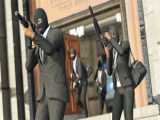The Uprisal of Tawwabin in Kufa
The division in power provided an opportunity for the Shia followers in Kufa to seek revenge for Imam Hossein’s blood from his killers. The Shias were outraged to see the killers of Imam Hossein living freely in Kufa. They were in deep sorrow after the tragedy of Karbala, and they felt guilty for inviting Imam Hossein to Kufa, but not supporting him. However, the Shia followers were split into two groups. One group was under the leadership of Mokhtar al-Thaqafi, a great warrior and politician, who initially wanted to establish a government in Kufa and then proceed to fight against the Umayyad army, which was under the leadership of Ibn Ziyad. The other group was called the Tawwabin, or the repenters, who were determined to seek revenge by waging a war against the Umayyad army. They were under the leadership of Sulayman ibn Surad al-Khuza’i, a Shia scholar and a companion of the Prophet and the Imams. The Tawwabin could not gather more than 4,000 troops, since many were leaning towards Mokhtar. They proceeded to the Battle of Ayn al-Wardah, and were defeated by Ibn Ziyad’s large army of around 30,000 troops, who tremendously outnumbered them. There is no historical evidence of any relationship between the Tawwabin and Imam Sajjad. The Tawwabin were ashamed to contact Imam Sajjad and invite him for an uprising since they had invited his father, Imam Hossein, to Kufa but had failed to support him. In addition, the Imam’s strategy was to avoid open involvement in any political activity. He was living with a few supporters in Medina and was far from his Shia followers in Kufa. The Imam had said, “We as the Ahlul-Bayt do not even have 20 people who love us within the entire cities of Mecca and Medina.” Any political activity by the Imam would have endangered his life in Medina. ویدیوهای مرتبط
ویدیوهای جدید



















